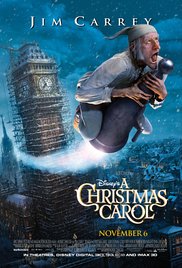 After taking his groundbreaking motion capture technology to insane extremes in 2007’s “Beowulf,” it made sense that Robert Zemeckis would up the ante in his retelling of Charles Dickens’ “A Christmas Carol.” However, to say that he upped the ante here would be a grand understatement. The effects work here is far beyond a tech wizard showing off; it’s more like watching Zemeckis lose his mind. He seems so obsessed with what he can do with the FX that he doesn’t stop to consider whether he should.
After taking his groundbreaking motion capture technology to insane extremes in 2007’s “Beowulf,” it made sense that Robert Zemeckis would up the ante in his retelling of Charles Dickens’ “A Christmas Carol.” However, to say that he upped the ante here would be a grand understatement. The effects work here is far beyond a tech wizard showing off; it’s more like watching Zemeckis lose his mind. He seems so obsessed with what he can do with the FX that he doesn’t stop to consider whether he should.
Jim Carrey, in one of several roles, is Ebenezer Scrooge, a penny-pinching miser who lives a joyless existence until one Christmas Eve, when he receives a visit from his deceased business partner Jacob Marley (Gary Oldman). Marley warns him that he will be visited by three spirits representing Christmases from the past, present and future. They give Scrooge some long-overdue perspective on his selfish ways, and scare the bejeezus out of him in the process.
There is nothing wrong with the movie being a little menacing, of course. It’s a cautionary tale designed to inspire the reader to be a better person, and death is one heck of a motivator. This movie should be a little scary. (Take the horses of the Ghost of Christmases to Come. Red eyes, yikes.) However, what Zemeckis does with the ghost of Jacob Marley isn’t just scary; it’s disturbing, and for no good reason. Indeed, there are a lot of for-no-good-reason moments here, including a downhill skiing bit that is completely out of place with the movie’s overall tone.
There is also the issue of the motion capture technology itself. It still looks a little odd, and when Zemeckis has his characters do something extraordinary (the dance sequence featuring Bob Hoskins’ Mr. Fezziwig and his wife, for example), it looks glitchy. Carrey is relatively subdued as Scrooge, but completely unhinged as the Ghost of Christmas Present, who looks a little like Carrey when he dressed as Jim Morrison for the MTV Movie Awards. Oldman and Colin Firth, who plays Scrooge’s nephew Fred, fare better, but they don’t get enough screen time to make much of a difference. This is Carrey and Zemeckis’ show, sometimes for better but ultimately for worse.
You can see what Zemeckis likes about motion capture technology; if only he knew when to stop. With “Beowulf” and “A Christmas Carol,” he got so drunk with the possibilities that he wound up putting the cart before the horse, and story took a back seat to visuals. No good will ever come of that, and this movie is no exception.



